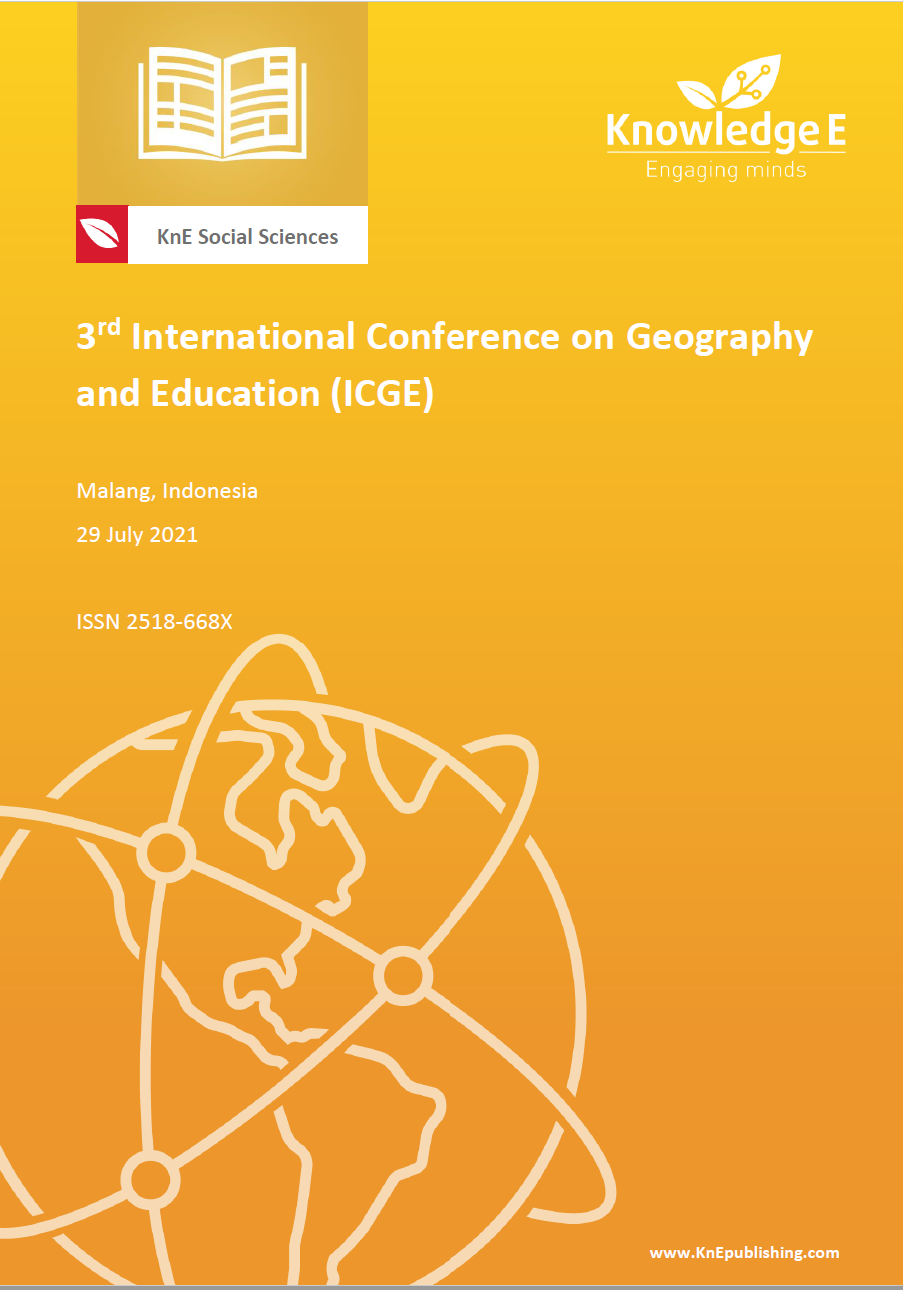Traditional Flood Mitigation by the Indigenous People of Sampang Madura
DOI:
https://doi.org/10.18502/kss.v7i16.12162Abstract
Flooding has taken place in Sampang every year for the last decade. However, before 2010, flooding in this area only occurred on average once every 5-10 years. This paper attempted to analyze the flood intensities and the traditional flood mitigation practices of indigenous people from Sampang. The authors used historical methods consisting of heuristics, criticism, interpretation, and historiography to analyze the problem. By perusing government archives, newspapers, photos, videos, and interviews, the authors learned that flooding in Sampang has become more frequent and the range has become wider than in earlier periods, and this is due to the geomorphological condition and unfinished construction of sheet pile in Sungai Kemuning. This condition causes the residents to be flooded every year. To cope with flooding the residents use traditional mitigation techniques before and after flooding. They can feel hawa banjir through environmental signs surrounding their place. They measure the flood water level with a wooden stick called brenggongan. As an early warning system, they use kentongan and cell phones (to call family or colleagues in the North). When the floods come, important goods are stored in a shelter called ra’ para’an or paray. Moreover, the upper-middle class usually builds an attic (loteng) in their house, while the lower-middle class prefers to raise the floor of their house.
Keywords: flood, traditional mitigation, Sampang, Madura
References
[2] Bappeda. Gambaran Umum Kabupaten Sampang. Archives collection of Bappeda Kabupaten Sampang. 2019. Madura: Kabupaten Sampang
[3] Arfaah S. Evaluasi Sistem Drainase Di Jalan Barisan Indah Kecamatan Sampang Kota Sampang. @ Trisula Universitas Darul Ulum Jombang. 2017 Aug 2;3(2):1-10.
[4] Bahri S, Iswahyudi A, Prabawa SE. RANACANG BANGUN SISTEM INFORMASI GEOGRAFIS (SIG) KASUS MITIGASI BENCANA BANJIR KABUPATEN SAMPANG BERBASIS WEB. InProsiding SEHATI (Seminar Nasional Humaniora dan Aplikasi Teknologi Informasi) 2017 Nov 10 (Vol. 3, No. 1, pp. 277-283).
[5] Brand W. Duitschers in Nederlandsch-Indië. Mens en Maatschappij. 1939 Jun 1;15(3):180-200.
[6] Badan Penanggulangan Bencana Daerah Kabupaten Sampang. Data bencana alam di kabupaten Sampang, 2015-2021. BPBD archives collection 2015-2021. Madura: Kabupaten Sampang
[7] Cahyaningrum GA. Bencana banjir di pulau Madura 1875-1940. Surabaya: Pustaka Indis; 2020.
[8] Darmawan K, Suprayogi A. Analisis tingkat kerawanan banjir di kabupaten sampang menggunakan metode overlay dengan scoring berbasis sistem informasi geografis. Jurnal Geodesi Undip. 2017 Feb 1;6(1):31-40.
[9] De Indische Courant. Bandjir in de Kotta; 1936, Jan 11.
[10] De Locomotief. Sampang onder water; 1939, Apr 24.
[11] Ghozali A, Sudaryatno S. Pemanfaatan Citra Penginderaan Jauh dan Sistem Informasi Geografis untuk Zonasi Kerawanan Banjir di DAS Kalikemuning Kabupaten Sampang, Madura. Jurnal Bumi Indonesia. 2016;5(4); 1-10.
[12] Haryani NS, Zubaidah A, Dirgahayu D, Yulianto HF, Pasaribu J. Model Bahaya Banjir Menggunakan Data Penginderaan Jauh Di Kabupaten Sampang (Flood Hazard Model Using Remote Sensing Data In Sampang District). Jurnal Penginderaan Jauh dan Pengolahan Data Citra Digital. 2012;9(1); 52-66.
[13] Istiqomah U. Disaster management: Studi peran pemerintah daerah dalam rehabilitasi dan rekonstruksi pasca banjir di kabupaten Sampang. Malang: Universitas Muhammadiyah Malang; 2019.
[14] Putri SJ. Analisa Daerah Rawan Banjir di Kabupaten Sampang Menggunakan Sistem Informasi Geografis Dengan Metode Data Multi Temporal (Doctoral dissertation) Surabaya Institut Teknologi Sepuluh Nopember. 2017 (Cited 2021 Jun 2)
[15] Kuntowijoyo K. Perubahan sosial dalam masyarakat agraris Madura, 1850-1940. Matabangsa, Yayasan Adikarya IKAPI, the Ford Foundation; 2002
[16] Kuntowijoyo K. Metodologi sejarah. Yogyakarta: Tiara Wacana; 2003.
[17] Kuntowijoyo K. Pengantar ilmu sejarah. Yogyakarta: Tiara Wacana; 2013.
[18] Liputan 6. Sampang kota bahari, banjir sehari-hari. Liputan6.com; 2016 Oct 30. Available from: https://Www.Liputan6.Com/Regional/Read/2638922/Sampang-Kota- Bahari-Banjir-Sehari-Hari
[19] Maat A. Mitigasi Tradisional Penduduk Sampang. Personal interview, Jul] Sampang; 2021 (unpublished).
[20] Nawiyanto S. Bencana dan pelestarian lingkungan: Pandangan etnik Jawa Dan Madura di wilayah ujung Timur Jawa. Paramita: Historical Studies Journal. 2012;22(1):41–55. https://doi.org/https://doi.org/10.15294/paramita.v22i1.1843
[21] Puspitasari D, Thaifururrahman M, Ariyanto R. PENGEMBANGAN SISTEM PENDETEKSI BANJIR MENGGUNAKAN FUZZY DENGAN RASPBERRY PI (STUDI KASUS: KABUPATEN SAMPANG). Jurnal Teknologi Informasi dan Terapan. 2017;4(2):89-96.
[22] Ridhoi R. et al., SEJARAH BANJIR SAMPANG, 1872-2020. Malang: Java; 2021.
[23] Ridhoi R, Natural hazard of Southern Malang: Sitiardjo flash floods, 1932–1939, in Embracing New Perspectives in History, Social Sciences, and Education, Routledge; 2023; pp. 44–48.
[24] Syamsiyah N. Sejarah Banjir di Sampang. [Personal interview, Jan] Sampang; 2021 (unpublished).
[25] Totok T. Sejarah Banjir di Sampang dan Mitigasi Tradisionalnya. [Personal interview, Sept] Sampang; 2021 (unpublished).
[26] Triwidiyanto A, Navastara AM. Pemintakatan risiko bencana banjir akibat luapan Kali Kemuning di Kabupaten Sampang. Jurnal Teknik ITS. 2013 Mar 1;2(1):C48-52.
[27] Wakil A. Mitigasi Tradisional Penduduk Sampang. [Personal interview, Sept] Sampang; 2021 (unpublished).

